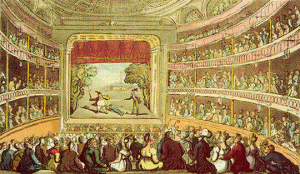Drury Lane Theatre
Drury Lane was managed by Garrick
Purcell’s Abdelazer was performed there in 1695
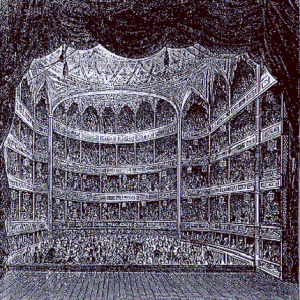
- Drury Lane Theatre
- Old and New London Illustrated
(London, 1873-78), Vol.III
[click on the picture to enlarge it]
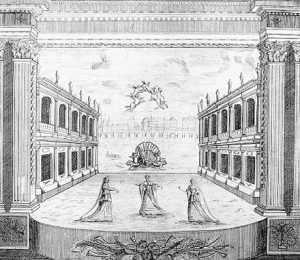
- Drury Lane Theatre
- Drury Lane, scenes for a prologue to the opera Arianna (1674)
[click on the picture to enlarge it]
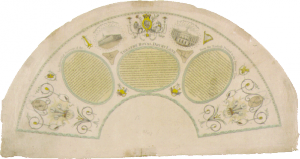
- Fan 192, Theatre Royal, Drury Lane
- Three large medallions, containing, as stated in an inscription above them, “An Historical Account of the Theatre Royal, Drury Lane. From the Earliest Period to the Present Time.”
Above, the royal arms between 2 small oval medallions, views of the old and new Theatres, and on either side the Prince of Wales’s feathers and other decorations. London. Published July 25, 1794 by John Cock and J.P.Crowder, Wood Street. Etching slightly coloured by hand.
[click on the picture to enlarge it]
Early in the last century there was a theatre in this Place which was either called the Phoenix or the Cockpit. Il was built or rebuilt about the year 1767 and pulled down by the Mob in the same year & was called the Phoenix from that fabulous bird being its sign. It was situated opposite the Castle Tavern in Drury Lane & was standing some time after the Restoration. The Players who performed at this Theatre in the time of James the First were called the Queen’s Servants till the death of Queen Anne in 1619. Some time denominated the Lady Elizabeth’s Servants and after the marriage of Charles the First they regained their former title of the Queen’s Players. How soon the theatre was rebuilt we are uncertain but the first Play in print which was acted is the Wedding by James Shirley printed in 1629, from which time till the silencing of the Theatres by the Fanatics a regular series of dramas performed there may be produced. On the revival of the Stage Sir W. Davenant in 1658 had possession of it, and presented such pieces as the times would admit, till the eve of the Restoration. At that period Mr. Rhodes, a Bookseller, who had formerly been Wardrobe Keeper at Black-friars Playhouse, fitted up the Cockpit and introduced plays there, which such performers as he could procure.
of which two Betterton and Kynaston had been his Apprentices. Soon Afterwards two Patents being obtained by Sir Wm Davenant and Thomas Killigrew. Rhodes’s Company were taken under the protection of the former & with him went to Lincolns Inns Fields, and were titled Servants of the Duke of York. The Company collected by Killigrew were called the Kings Servants and acted first in a house near Clare Market. But this Theatre not being well adapted, a more convenient one was erected on the same Spot which the present Theatre occupies was opened April 8th 1662 which soon took fire, and was entirely destroyed, with fifty or sixty houses adjoining were burnt or blown up. The Theatre was again built with such improvements as might be suggested and for that purpose employed Sir Christopher Wren, the principal artist of the time. The new Theatre being finished was opened March 26th 1674. On this occasion a Prologue and Epilogue were deliver’d, both written by Mr. Dryden. The population of London at that period, or the tastes of the times insufficient to maintain two Theatres. It was therefore agreed a few years after by the Patentees to unite the Companies and perform only at one Theatre Drury Lane. Soon after both Patents became the property of Crr. Rich.
who having misconducted himself in the management was silenced by the Chamberlain in 1709, from which time the Drury Lane Company ceased to act under either of King Charles’s Patents. In the first year of George the First a licence was granted to Sir Richd Steele for his life and three years afterwards to establish a company which under the management of himself, Wilks Booth &Gibber continued to act with great success at Drury Lane, till the death of the two former, and the succession of the latter, threw the property of the Theatre in 1733 into the hands of Mr Highmore who being ruined by the scheme, the Theatre was purchased by Chas. Fleetwood, whose management terminated especially unfortunate with that of his predecessor. In 1747 the successful management of Mr Garrick & Lacy commenced which continued until the year 1776 when the property passed to the present proprietors who have erected a Theatre which stands unrivald. The Plan is the production of Mr Holland. It open’d April 21.1794 with Macbeth, the scenes, decorations &c. entirely new. A prologue was spoken by Mr. Kemble and an Epilogue by Miss Farren.
Vol.11 104-207 Unmounted fans, Schreiber collection p.87 An Historical Account of the Theatre Royal, Drury Lane, from the Earliest Period to the present time
Fans also represented fairs
Top of Page
Covent Garden Theatre
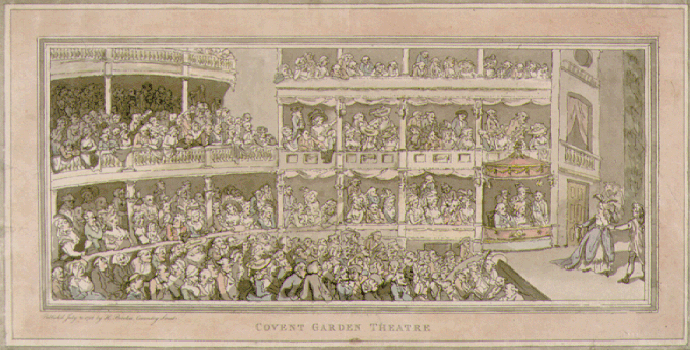
- Covent Garden Theatre
- (British Museum)
[click on the picture to enlarge it]
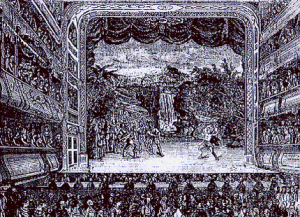
- Interior of Drury Lane Theatre in 1804
- Old and New London Illustrated
(London, 1873-78), Vol.III
[click on the picture to enlarge it]
Doctor Syntax at Covent Garden Theatre.
He hasten’d to the Playhouse door,
And took his place within the pit,
Beside a critic and a wit;
......................................................
“I think,” said Syntax, looking round,
“It is not good, this vast profound: -”I see no well-wrought columns here;
“No Attic ornaments appear;”Nought but a washy, wanton taste
Of gaudy tints and puny taste:
“Too large to hear - too long to see -”Full of unmeaning symmetry.
“The parts all answer one another;”Each pigeon-hole reflects its brother;
“And alas! too plainly show”How easy ’tis to form a Row.
"But where’s the grand, the striking whole?-
A Theatre should have a soul.
William Combe, The Tour of Dr Syntax,
3rd ed., vol.1 (London: Ackerman, 1813).
Top of Page
Haymarket Theatre
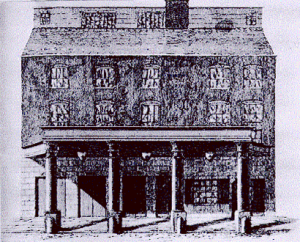
- Theatre Royal, Haymarket
- From an engraving by Hixon before the theatre was demolished in 1821. it was constructed john Potter in 1720, largely as a remodelling of the King’s Head Inn between Little Suffolk Street and James Street. Known first as the “New Theatre” it was later called “The Little Theatre” to distinguish it from the larger King’s Theatre, Haymarket.
[click on the picture to enlarge it]
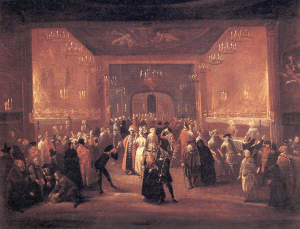
- Haymarket Theatre
- Grisoni Masquerade at Haymarket Theatre 1724
[click on the picture to enlarge it]








